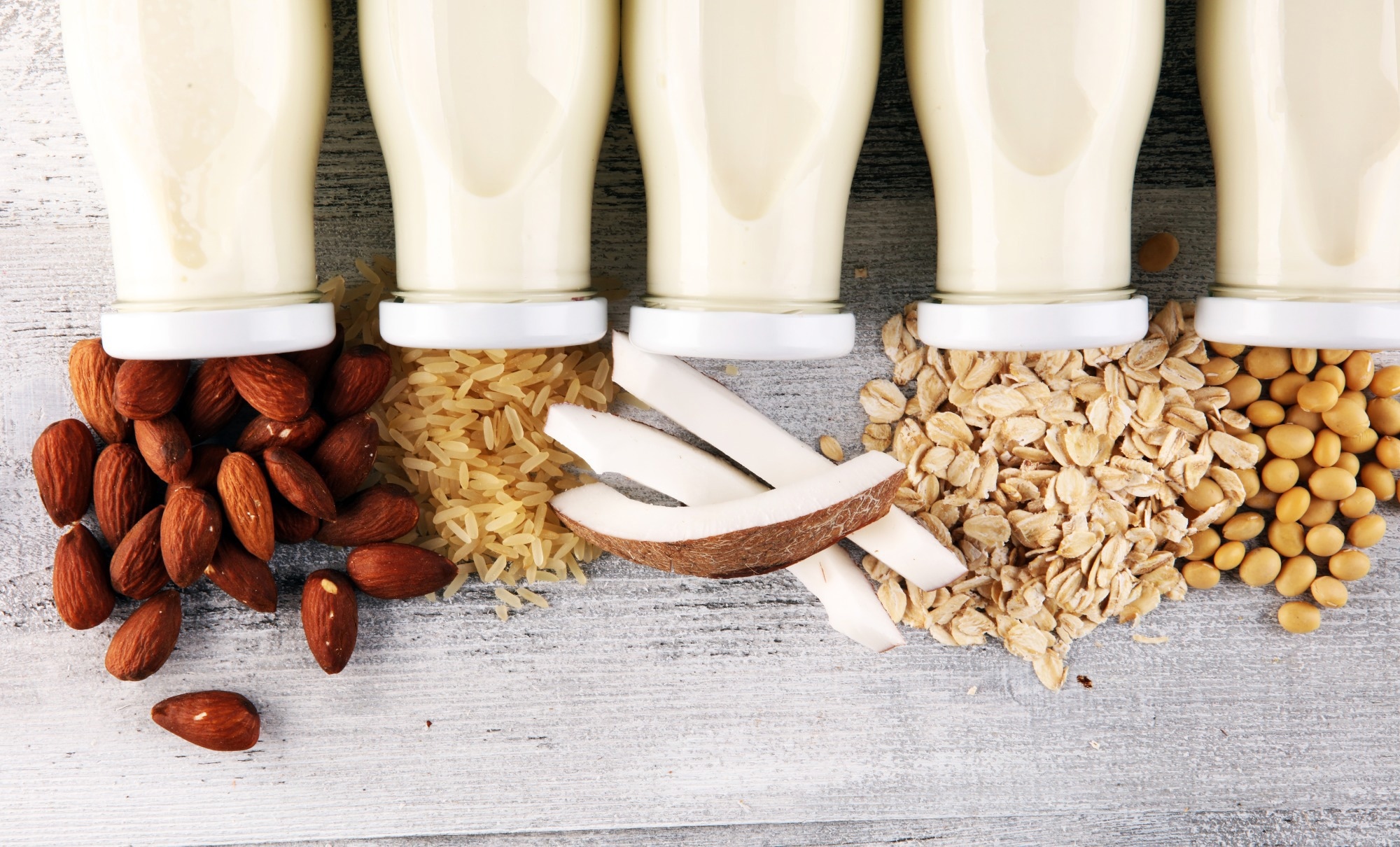In a recent study published in the Foods journal, researchers explored the association between plant-based dairy alternatives (PBDAs) and the human diet.
 Study: Plant-Based Dairy Alternatives—A Future Direction to the Milky Way. Image Credit: beats1/Shutterstock.com
Study: Plant-Based Dairy Alternatives—A Future Direction to the Milky Way. Image Credit: beats1/Shutterstock.com
Background
Sales of PBDAs have grown extensively in the previous decade and are expected to rise further. Various sources like cereals, legumes, pseudocereals, nuts, and seeds can be utilized for food product development.
These products include vegetal milk, cheese, yogurt, cream, butter, and sweets like ice cream. The nutritional profiles of these products are comparable to those of animal-based products. PBDAs are gaining popularity among individuals with specific dietary requirements.
While several studies have assessed the effects of PBDAs on human health, in vivo studies are still lacking.
Plant-based dairy alternatives
Plant-based milk alternatives (PBMAs)
PBMAs have gained significant potential as a replacement for mammalian milk. PBMAs utilize cereals, legumes, pseudocereals, seeds, and nuts as raw materials. Concerning macronutrients, PBMAs have a lower protein content than bovine milk.
Also, animal proteins have a higher nutritional value and digestibility than plant proteins. Furthermore, while PBMAs are cholesterol-free and lactose-free, they are high in unsaturated fatty acids.
Regarding the micronutrient content, PBMAs have a lower proportion of vitamins and minerals with less consistent absorption than milk. However, plant milk is usually enriched with vitamins and minerals like calcium to enhance its nutritional value.
PBMAs contain some elements absent in bovine milk, like dietary fibers and isoflavones. Hence, it is important to compare plant milk's fat, protein, and energy contents to bovine milk to determine the appropriate substitution of animal milk with plant milk.
Plant-based cheese alternatives (PBCAs)
The production principle of PBCAs is to match the physicochemical and sensory properties of a known conventional cheese. The various processing methods distinguish the many types of traditional cheese.
Since there are numerous raw materials, choosing the right process and ingredients is necessary when making PBCAs. Polysaccharides, proteins from potatoes, legumes, nuts, seeds, zein, and various solid fats at room temperature are all sources of PBCAs.
Several techniques, including altered fermentation processes, the blending of PBMAs, and altered soybean processing, have been used to enhance the sensory qualities of PBCAs, particularly of soy-based cheese. To increase the marketability of PBCAs, more study is required to determine how plant-based elements must be obtained and processed to provide the appropriate structure and tastes.
Plant-Based Cream Alternatives (PBCrAs)
Oleogels are gaining attention for their potential to substitute vegetable fat for milk fat in dairy cream, specifically in PBCrAs. Oleogels have over 90% liquid vegetable oil and a solid-like gel structure.
Filling cream production has successfully utilized them as a fat replacer. Plant proteins are being utilized as substitutes for animal proteins in PBDAs, along with plant-based fat replacers. PBCrA emulsions were produced using various plant protein isolates with different protein proportions and homogenization pressures.
Studies have found that homogenization altered the surface-active properties and the functionality of proteins, resulting in a stable cream emulsion.
Plant-Based Yogurt Alternatives (PBYAs)
The nutritional benefits of PBMAs and by-products, including calcium, high-quality proteins, PUFA, and isoflavones, are generating significant attention for their potential to prevent bone degradation and instill anticancer effects.
Almond, soy, and coconut milk are commonly used in PBYA production. However, PBYAs have texture and stability restrictions in comparison to dairy yogurts.
Cow milk and soymilk yogurts were tested for Lactobacillus acidophilus and Bifidobacterium lactis. Lactobacillus proliferated more rapidly than Bifidobacteria in cow milk yogurts and soymilk yogurt substitutes during storage.
Soymilk yogurt alternatives were found to be less palatable than cow milk yogurt with respect to texture, taste, and overall acceptability due to their low viscosity and beany flavor.
Plant-Based Butter Alternatives (PBBAs)
Plant-based alternatives have been developed and tested to replace animal fat and introduce beneficial compounds in different diets.
The use of PBBAs as a substitute for dairy butter has seen a significant rise in consumption. New types of peanut butter alternatives have been created to address peanut allergies. These include soy, cashew, almond, pistachio, and sesame butter.
Peanut butter had high levels of calories and lipids, while soybean butter exhibited high protein and moisture levels.
Cooked and sprouted soybean butter alternatives exhibited greater stability than commercial peanut butter during microbiological testing. Fried soybean butter received the lowest acceptability rating, while sprouted soy butter was rated the highest regarding the sensory appeal.
Conclusion
The study findings noted the ongoing development of PBDAs and their various sources, which provide important nutrients for human health.
Plant-based dairy alternatives have been shown to improve various parameters and benefit different pathologies. However, further studies are required to determine the long-term effects and administration for individuals with specific dietary needs.